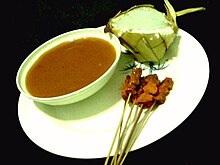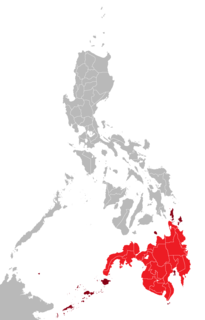
Mindanao is the second-largest island in the Philippines, after Luzon and seventh-most populous island in the world. Located in the southern region of the archipelago, the island is part of an island group of the same name that also includes its adjacent islands, notably the Sulu Archipelago. As of 2015 census, Mindanao has 25,700,000 inhabitants, while the entire island group has an estimated population of 27,021,036 as of 2021.

Satay, or sate in Indonesian and Malay spelling, is a Southeast Asian dish of seasoned, skewered and grilled meat, served with a sauce. The earliest preparations of satay is believed to have originated in Javanese cuisine, but has spread to almost anywhere in Indonesia, where it has become a national dish. Indonesian satay is often served with kecap manis – a sweet soy sauce, and is often accompanied with lontong, a type of rice cake, though the diversity of the country has produced a wide variety of satay recipes. It is also popular in many other Southeast Asian countries including Brunei, Malaysia, Philippines, Singapore and Thailand. It also recognized and popular in Suriname and the Netherlands. In Sri Lanka, it has become a staple of the local diet as a result of the influences from the local Malay community.
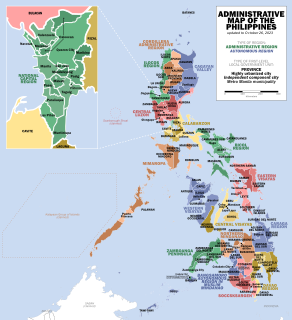
In the Philippines, regions are administrative divisions that primarily serve to coordinate planning and organize national government services across multiple local government units (LGUs). Most national government offices provide services through their regional branches instead of having direct provincial or city offices. Regional offices are usually but not necessarily located in the city designated as the regional center.

Zamboanga del Sur, officially the Province of Zamboanga del Sur, is a province in the Philippines located in the Zamboanga Peninsula region in Mindanao. Its capital is the city of Pagadian. Statistically grouped with Zamboanga del Sur is the highly urbanized city of Zamboanga, which is geographically separated and a chartered city and governed independently from the province.

Zamboanga Peninsula is an administrative region in the Philippines, designated as Region IX. It consists of three provinces including four cities, and the highly urbanized Zamboanga City. The region was previously known as Western Mindanao before the enactment of Executive Order No. 36 on September 19, 2001. The city of Zamboanga was designated as the regional center until Pagadian was designated as its new regional center, although Zamboanga City remains the region's cultural, economic, and educational center.

The Autonomous Region in Muslim Mindanao was an autonomous region of the Philippines, located in the Mindanao island group of the Philippines, that consisted of five predominantly Muslim provinces: Basilan, Lanao del Sur, Maguindanao, Sulu, and Tawi-Tawi. It was the only region that had its own government. The region's de facto seat of government was Cotabato City, although this self-governing city was outside its jurisdiction.

Dipolog, officially the City of Dipolog, is a 3rd class component city and capital of the province of Zamboanga del Norte, Philippines. According to the 2020 census, it has a population of 138,141 people.
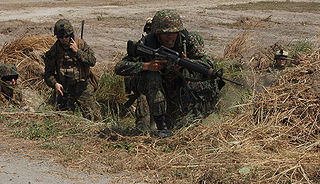
Operation Enduring Freedom – Philippines (OEF-P) or Operation Freedom Eagle was part of Operation Enduring Freedom and the global War on Terror. The Operation targeted the various Jihadist terror groups operating in the country. By 2009, about 600 U.S. military personnel were advising and assisting the Armed Forces of the Philippines (AFP) in the Southern Philippines. In addition, by 2014, the CIA had sent its elite paramilitary officers from their Special Activities Division to hunt down and kill or capture key terrorist leaders. This group had the most success in combating and capturing Al-Qaeda leaders and the leaders of associated groups like Abu Sayyaf.

Pagadian, officially the City of Pagadian, is a 2nd class component city and the capital of the province of Zamboanga del Sur, Philippines. It is the regional center of Zamboanga Peninsula and the second-largest city in the region, after the independent city of Zamboanga. According to the 2020 census, it has a population of 210,452 people.
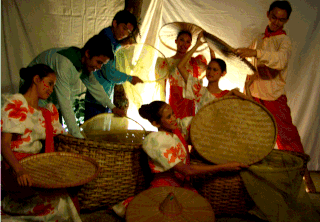
Filipino cuisine is composed of the cuisines of more than a hundred distinct ethno-linguistic groups found throughout the Philippine archipelago. However, a majority of mainstream Filipino dishes that compose Filipino cuisine are from the cuisines of the various ethnolinguistic groups and tribes of the archipelago, including the Ilocano, Pangasinan, Kapampangan, Tagalog, Bicolano, Visayan, Chavacano and Maranao ethno-linguistic groups. The style of food making and the food associated with it have evolved over many centuries from their Austronesian origins to a mixed cuisine of Chinese, Spanish and American influences, in line with the major waves of influence that had enriched the cultures of the archipelago, as well as others adapted to indigenous ingredients and the local palate.

Torta is a culinary term that can, depending on the cuisine, refer to cakes, pies, flatbreads, sandwiches, or omelettes.

Barbecue varies by the type of meat, sauce, rub, or other flavorings used, the point in barbecuing at which they are added, the role smoke plays, the equipment and fuel used, cooking temperature, and cooking time.
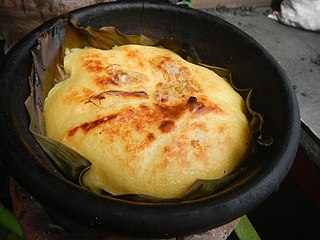
Bibingka is a type of baked rice cake from the Philippines. It is usually eaten for breakfast, especially during the Christmas season. It is traditionally cooked in clay pots lined with leaves. It is a subtype of kakanin in Philippine cuisine. Bibingka is also found in East Timor and Christian communities in eastern Indonesia.

Peanut sauce, satay sauce, bumbu kacang, sambal kacang, or pecel is an Indonesian sauce made from ground roasted or fried peanuts, widely used in cuisines worldwide.

The vinta is a traditional outrigger boat from the Philippine island of Mindanao. The boats are made by Sama-Bajau, Tausug and Yakan peoples living in the Sulu Archipelago, Zamboanga peninsula, and southern Mindanao. Vinta are characterized by their colorful rectangular lug sails (bukay) and bifurcated prows and sterns, which resemble the gaping mouth of a crocodile. Vinta are used as fishing vessels, cargo ships, and houseboats. Smaller undecorated versions of the vinta used for fishing are known as tondaan.

Pastel is the Spanish and Portuguese word for pastry, given to different typical dishes of many countries that speak or spoke those languages.
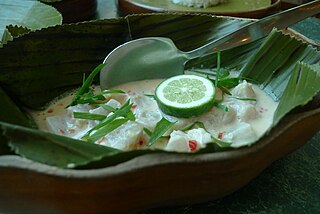
Kinilaw is a raw seafood dish and preparation method native to the Philippines. It is also referred to as Philippine ceviche due to its similarity to the Latin American dish ceviche. It is more accurately a cooking process that relies on vinegar or acidic fruit juices to denature the ingredients, rather than a dish, as it can also be used to prepare meat and vegetables. Kinilaw dishes are usually eaten as appetizers before a meal, or as finger food with alcoholic drinks.

Inihaw, also known as sinugba or inasal, are various types of grilled or spit-roasted barbecue dishes from the Philippines. They are usually made from pork or chicken and are served on bamboo skewers or in small cubes with a soy sauce and vinegar-based dip. The term can also refer to any meat or seafood dish cooked and served in a similar way. Inihaw are commonly sold as street food and are eaten with white rice or rice cooked in coconut leaves (pusô). Inihaw is sometimes referred to as Filipino barbecue or (informally) Pinoy BBQ.

Zamboanga City, officially the City of Zamboanga, is a 1st class highly urbanized city in the Zamboanga Peninsula region of the Philippines. According to the 2020 census, it has a population of 977,234 people. It is the sixth-most populous and third-largest city by land area in the Philippines. It is the commercial and industrial center of the Zamboanga Peninsula Region.

Pastil, or pastel, is a Filipino packed rice dish made with steamed rice wrapped in banana leaves with dry shredded beef, chicken, or fish. It originates from the Maguindanao people and is a popular, cheap breakfast meal in Mindanao, especially among Muslim Filipinos. Pastil is also known as patil, patel, patir, or pater in Maranao; and paster in Iranun.
